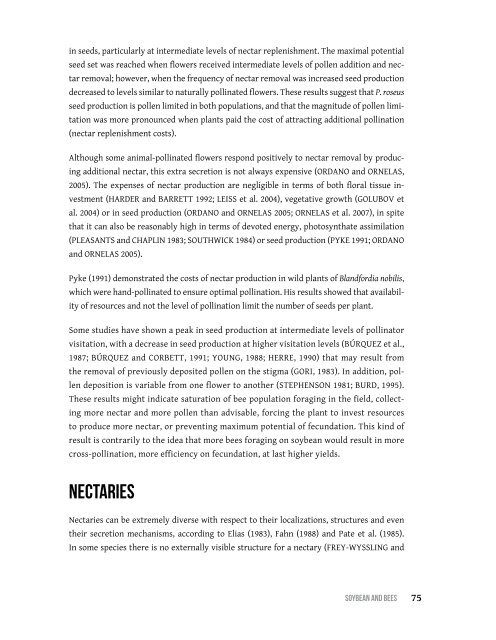Soybean and Bees
Create successful ePaper yourself
Turn your PDF publications into a flip-book with our unique Google optimized e-Paper software.
in seeds, particularly at intermediate levels of nectar replenishment. The maximal potential<br />
seed set was reached when flowers received intermediate levels of pollen addition <strong>and</strong> nectar<br />
removal; however, when the frequency of nectar removal was increased seed production<br />
decreased to levels similar to naturally pollinated flowers. These results suggest that P. roseus<br />
seed production is pollen limited in both populations, <strong>and</strong> that the magnitude of pollen limitation<br />
was more pronounced when plants paid the cost of attracting additional pollination<br />
(nectar replenishment costs).<br />
Although some animal-pollinated flowers respond positively to nectar removal by producing<br />
additional nectar, this extra secretion is not always expensive (Ordano <strong>and</strong> Ornelas,<br />
2005). The expenses of nectar production are negligible in terms of both floral tissue investment<br />
(Harder <strong>and</strong> Barrett 1992; Leiss et al. 2004), vegetative growth (Golubov et<br />
al. 2004) or in seed production (Ordano <strong>and</strong> Ornelas 2005; Ornelas et al. 2007), in spite<br />
that it can also be reasonably high in terms of devoted energy, photosynthate assimilation<br />
(Pleasants <strong>and</strong> Chaplin 1983; Southwick 1984) or seed production (Pyke 1991; Ordano<br />
<strong>and</strong> Ornelas 2005).<br />
Pyke (1991) demonstrated the costs of nectar production in wild plants of Bl<strong>and</strong>fordia nobilis,<br />
which were h<strong>and</strong>-pollinated to ensure optimal pollination. His results showed that availability<br />
of resources <strong>and</strong> not the level of pollination limit the number of seeds per plant.<br />
Some studies have shown a peak in seed production at intermediate levels of pollinator<br />
visitation, with a decrease in seed production at higher visitation levels (Búrquez et al.,<br />
1987; BÚRQUEZ <strong>and</strong> CORBETT, 1991; Young, 1988; Herre, 1990) that may result from<br />
the removal of previously deposited pollen on the stigma (Gori, 1983). In addition, pollen<br />
deposition is variable from one flower to another (Stephenson 1981; Burd, 1995).<br />
These results might indicate saturation of bee population foraging in the field, collecting<br />
more nectar <strong>and</strong> more pollen than advisable, forcing the plant to invest resources<br />
to produce more nectar, or preventing maximum potential of fecundation. This kind of<br />
result is contrarily to the idea that more bees foraging on soybean would result in more<br />
cross-pollination, more efficiency on fecundation, at last higher yields.<br />
Nectaries<br />
Nectaries can be extremely diverse with respect to their localizations, structures <strong>and</strong> even<br />
their secretion mechanisms, according to Elias (1983), Fahn (1988) <strong>and</strong> Pate et al. (1985).<br />
In some species there is no externally visible structure for a nectary (Frey-Wyssling <strong>and</strong><br />
SoybeAn <strong>and</strong> bees<br />
75


